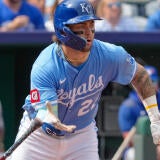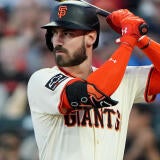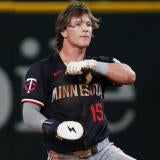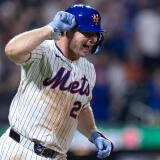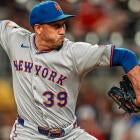Fantasy Baseball: 20 bold predictions for 2026 highlight Shane Bieber, Ozzie Albies and Payton Tolle
Some early thoughts for 2026 that push the boundaries of the reasonable
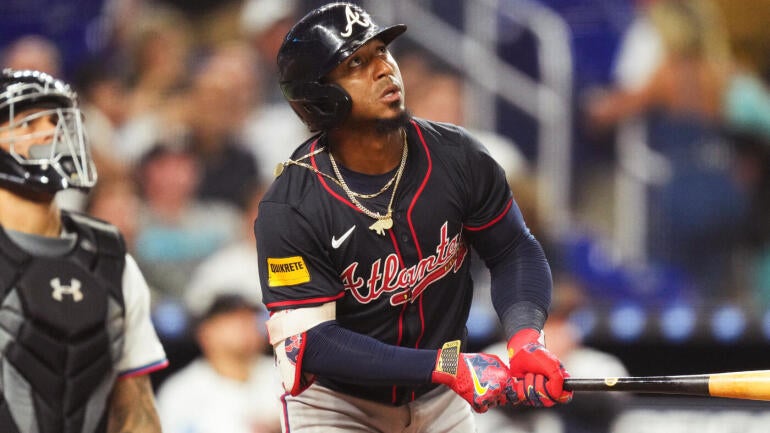
The season isn't quite over yet. I have your attention still. Whatever is left for you to wring out of the waiver wire is well spoken for already, so how about a change of pace? Let's start talking 2026.
And let's do it in the most reckless way imaginable, by predicting a bunch of things that ... eh, probably won't be correct.
But they'll at least be directionally correct. I'm exaggerating to drive home a point, in other words, but with the important caveat that the exaggeration is at least within the realm of possibility. That's what makes for a bold prediction, and that's the most enjoyable kind of prediction this far out.
You wanna get nuts? Let's get nuts!
Nick Kurtz is the top first baseman drafted and still goes too low
This one won't seem so bold by the time we're actually drafting, but sitting here in early September, it may not have occurred to you just how well the rookie rates at one of the most star-studded positions. Kurtz is a distant No. 1 in Head-to-Head points per game and is No. 1 outright in Rotisserie since reaching the majors on April 23 -- and that's in spite of a miserable first month in which he hit .208 with a .558 OPS. We've seen high draft picks with collegiate experience steamroll the minors only to meet with a harsh dose of reality upon reaching the majors (looking at you, Wyatt Langford), but Kurtz has thrived in a way that seems almost effortless. Detractors will point to his high strikeout rate and say correction is coming to his batting average, but I think the correction will be to the strikeout rate itself, making Kurtz a possible Triple Crown threat.
Shane Bieber places in the top five in Cy Young voting
Part of me wants to say top three, but since I'm already penciling Tarik Skubal and Garrett Crochet into two of those spots, I want to leave myself a little wiggle room. Top five should be bold enough for a pitcher in his first full year back from Tommy John surgery, particularly one who only had a 3.80 ERA in his last meaningful sample. It's the meaningless sample in between that has me so bullish. That 3.80 ERA led to Bieber working with Driveline Baseball prior to 2024 to regain some of the velocity he had lost since winning a Cy Young in 2020, and it seemed to translate, seeing him strike out 20 in 12 innings prior to succumbing to Tommy John surgery. The velocity bump has held post-surgery, and the results have been sparkling as well. Bieber will be on an expiring contract for the Blue Jays in 2026, so I doubt they'd blink at him taking on a full workload, even so soon after surgery.
The Orioles reach the postseason
Despite being one of the most disappointing teams this year, the Orioles still have ample reason for optimism, beginning with their strong offensive nucleus. Gunnar Henderson, Adley Rutschman, and Jackson Holliday all endured some growing pains while Jordan Westburg struggled to stay on the field, but I don't think anyone is counting them out from reaching their full offensive potential. And now Samuel Basallo and Dylan Beavers are part of the equation. I would have said coming into the year that the Orioles didn't have the pitching to compete, but they've since seen Trevor Rogers return to form and Kyle Bradish return to health. They'll presumably go hard after a front-line starter in the offseason, having been humbled by this lost season.
And so do the Braves
Unlike the Orioles, the Braves had all the pitching they needed at the start of the year but were operating with four automatic outs in their lineup. They knowingly punted at shortstop with Nick Allen, but then had to replace a suspended Jurickson Profar with table scraps while Michael Harris and Ozzie Albies fought through debilitating slumps. The second half has shown what their offense can be with everyone up to their usual form -- and that was true even before they replaced Allen with Ha-seong Kim. Unfortunately, by the time the offense got going, Chris Sale, Spencer Schwellenbach and Grant Holmes were lost to injury. Sale has since returned, and Schwellenbach should be fine for 2026. How much the Braves get from Spencer Strider and Reynaldo Lopez moving forward is anybody's guess, but I think, like the Orioles, they'll look to add an arm in the offseason, having more funds to work with after resetting their luxury tax penalty this year.
Ozzie Albies bounces back as a top five second baseman
Here's one of the many ways 2026 figures to be better than 2025 for the Braves. Ozzie Albies was one of their four automatic outs in the first half, going that whole time without a single homer from the right side of the plate. Historically, he's only needed to tread water from the left side. It's his dominance from the right side that would bring his numbers in line. Seeing his platoon splits that far out of whack makes me more hopeful it's something he can correct, like a mechanical flaw, when before I worried he may be a casualty of a shifting league environment. Already, we're seeing evidence of that with his two homers from the right side in the second half. Hitting coach Tim Hyers has also suggested that Albies was still afflicted by last year's fractured wrist until recently, offering more reason to believe that his sudden turnaround is a more permanent return to form.
Noelvi Marte has more Head-to-Head points than Elly De La Cruz
Go bold or go home, right? This isn't meant as a knock on De La Cruz, who's still firmly part of the first-round discussion, and I wouldn't dare suggest that Marte could finish ahead of him in a 5x5 categories league (such as Rotisserie), where his stolen bases are more impactful and his strikeouts are of no consequence. In Head-to-Head points, though, where strikeouts do count for something, the gap may be enough to tip the scales in Marte's favor, but that's only if he's a masher in his own right. I think he can be. He has the exit velocities for it and makes contact at a nice rate for a player who can hit the ball in excess of 115 mph. He's also a capable base-stealer, his sprint speed measuring in the 88th percentile. The fact is that Marte is capable of impacting the game in more ways than De La Cruz (if not to the same extent), and while it may never quite elevate him to first-round status, it could bring him pretty close.
Brice Turang hits 25 home runs
This prediction would seem bolder if Brice Turang hadn't just hit 10 home runs in August. If he does that again in September, well, he's at 27 for 2025, putting him past the threshold that I'm boldly predicting here. But of course, no one is thinking he'll do that. It was a stretch to think he might hit 10 home runs in an entire season prior to him doing it in that one month, and lightning doesn't strike twice. One development that may have gone unnoticed prior to Turang's big August, though, is how much harder he's hitting the ball this year. His average and max exit velocity are both up more than 3 mph from last year, which is a huge leap. It wasn't translating to power because his swing was geared for hitting line drives the other way, but that's what changed in August. His pull-air rate exploded, and if that remains his approach going forward, his new exit velocities will make power inevitable. A 25-homer season for a former 50-steal guy? Just how high does the upside go here?
Ben Rice hits over .290 with an OPS over .900
All I'm doing here is saying that Rice is exactly who Statcast makes him out to be. His Baseball Savant page is lit up by bright red bars that read 94th percentile or better in all the major hitting metrics, such as xBA (.293) and xSLG (.576). If he just lives up to those, he meets this prediction easily.
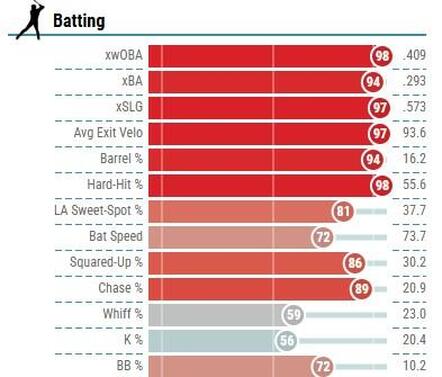
Of course, he wouldn't be the first hitter to routinely fall short of Statcat's expectations, but we've learned this year that a low pull-air rate can usually explain such shortfalls. Rice excels there, too, his 26.5 percent rate placing him in the 93rd percentile. The 26-year-old is everything you could want a hitter to be, right down to him batting left-handed at Yankee Stadium, and as a full-time first baseman next year (one with catcher eligibility, no less), he should achieve his final form.
At least five catchers score more Head-to-Head points than J.T. Realmuto had in his best season
I'm using Realmuto as a frame of reference because he was long considered the gold standard at catcher, routinely drafted No. 1 at the position. His highest Head-to-Head point total in a single season was 441.5 in 2019. Cal Raleigh has already topped that number this year, and William Contreras is on pace to thanks to his second-half surge. Let's pencil them in for 2026 as well, but who else?
Well, Ben Rice would easily meet the mark if he meets my bold prediction for him (see above). Hunter Goodman probably doesn't have the plate discipline for it, projecting for 412 points (along with 32 homers and 95 RBI) even in a year when everything has gone right. Drake Baldwin, though, presents a near flawless hitting profile and will presumably take on a bigger portion of catching responsibilities next year. Agustin Ramirez and Samuel Basallo both offer massive upside and project to take a big step forward. Kyle Teel has begun to flash real potential of his own, and I'm not ruling out a return to form for Adley Rutschman, who scored 463.5 points in 2023. That's not even mentioning standbys like Will Smith, Shea Langeliers, Salvador Perez, Yainer Diaz and, yes, Realmuto. Bottom line is that the position has so much to offer than in those days when Realmuto stood atop the rankings, and I only see it getting better.
Spencer Strider bounces back with 200-plus strikeouts
The bloom is fully off the rose now. Only once in his past six starts has Strider struck out more than three batters, putting together an 8.16 ERA during that time and marking his return from elbow surgery as a big enough dud that he may never recover from it.
But I think he will. It's easy to forget that he had a seven-start stretch earlier this year with a 2.53 ERA, 1.08 WHIP and 12.2 K/9. Things were looking up then, mostly on the strength of a slider that still rates as one of the best of the game. The problem is that he has nothing to go with it but a fastball, which itself rated as an elite pitch before the injury. It has since lost some velocity and, more notably, its characteristic "rising" effect that causes hitters to swing underneath it. Strider is aware of this and, for one start on Aug. 25, seemed to recapture that shape after working with Maven Baseball Lab in Atlanta. It'll take more time in the lab this offseason for that change to stick, probably, but at least there's proof of concept. And if Strider works to expand his arsenal as another potential safeguard, even better.
Dylan Cease shaves two runs off of his ERA
Maybe a 2.81 ERA, which is what this prediction would translate to at this particular moment, is a touch optimistic, but this is a bold prediction, after all. Cease did have a 2.20 ERA in 2022, so a 2.81 mark is in the realm of the reasonable. The bottom line is that I don't think anything is actually wrong with him. His strikeout rate is still fourth-best among qualifiers. His walk rate, while not good, is in line with career norms. What we've seen from Cease this year is the typical variance that accompanies a pitcher with good stuff but bad control. You could basically sum up his whole career this way. It's why his past four seasons have alternated between Cy Young-caliber and not so good. Just playing the odds, then, you'd bet on his ERA settling back into the mid-threes, where it was last year and where all the estimators say it should be now. Getting to the high twos from there isn't a big leap.
Roman Anthony leads the Red Sox in home runs
This is a bet on talent as much as anything. We know Anthony impacts the ball like an elite slugger, placing behind only Oneil Cruz, Aaron Judge, Shohei Ohtani and Kyle Schwarber in average exit velocity. It's just a matter of him actualizing that power by angling the ball off the bat properly. This was the read on him in the minors as well, and it didn't stop him from being the consensus top prospect at the time of his promotion. Already, we were seeing him make strides with six homers in his final 21 games before suffering a season-ending oblique injury, and looking over the Red Sox's roster, he seems like the most reasonable bet for 30-plus homers next year, regardless of his pace this year.
Bryan Reynolds gets traded and goes on to deliver his best OPS in five years
Reynolds is the hitter version of Dylan Cease in that there's little in the underlying data to explain why he's been so much worse this year, which inclines me to believe it's just one of those things. "Variance" would be the more sophisticated way of putting it. If you want to harp on his strikeout rate being his highest since 2020, fair enough, but his expected stats, which take strikeout rate into account, are virtually identical to last year. In short, Statcast thinks he should be hitting .272 and slugging .474, which is more or less the player we've always known him to be. The reason I'm saying "best in five years" is because his .912 OPS in 2021 (incidentally, the year after his other high-strikeout season) is unlikely to be repeated. Then again, we've never seen him play for a team with something to play for, so a trade could propel him to new heights.
Matthew Boyd, Andrew Abbott both have an ERA over 4.00
I have to go negative with one of these predictions, don't I? A certain pitcher phenotype has excelled in a way that's unique to 2025. I'd define it as a left-hander who doesn't throw especially hard, doesn't miss bats at an above-average rate, and doesn't put the ball on the ground nearly as much as you'd want given those shortcomings. But he does throw a lot of strikes and induces mostly weak contact. Normally, I'd say such a pitcher could be serviceable in Fantasy, but with pronounced ERA concerns. Something about the league environment this year, though, has allowed that phenotype to play beyond its capabilities, with Boyd (2.94 ERA) and Abbott (2.65 ERA) being the most prominent examples.
The biggest lesson I've learned in the past four years is that the way the ball is playing one year won't necessarily be the way it plays the next, so identifying those one-off environmental darlings and fading them in drafts would seem to be the wisest course of action.
Jakob Marsee has more combined home runs and stolen bases than Jarren Duran
This prediction is performing double duty. On the one hand, it's acknowledging that Duran is much more beatable in this metric than he might have seemed a year ago. A combined 40 homers and steals may be all it takes, and frankly, that's more believable than the combined 55 he had in 2024, a year that wrung out every last bit of the production he has to offer. But this prediction is also expressing confidence in Marsee, a top minor-league performer who never rated as much of a prospect because of subpar exit velocity readings but who has continued to do the same things that got him called to the majors in the first place, namely working the count, running with reckless abandon, and directing the ball to the shortest part of right field. He's capable of impacting the game in so many ways that even if he falls short in one area, he's likely to be of value still.
Luke Keaschall leads all second basemen in OPS
Before I address Keaschall specifically, let me remind you that a certain fellow named Ketel Marte still plays second base, and Marte is presently enjoying his second straight year (and fourth overall) with an OPS over .900. I don't think Keaschall is as good of a hitter as Marte. He simply doesn't impact the ball the same way. But what may put him slightly ahead is the O in OPS, on-base percentage. It's going to be tough because Marte himself is great at drawing walks, but Keaschall has a chance to be even better. He reached base at a .420 clip in the minors last year and is so far at .404 in the majors.
So is this prediction a technicality? What about leagues where walks don't matter? Fortunately, Keaschall has also shown himself to be a prolific base-stealer, as was also true in the minors. And to be clear, he has the ability to put the ball in the bleachers, too. He just relies more on hitting it at the proper angles than Marte does.
Shane Baz blossoms into an ace
Even though the full-season line for Baz is sorely lacking, there have been flashes this year, from the two double-digit strikeout efforts in April to the four-start stretch with a 2.30 ERA, 1.02 WHIP and 9.9 K/9 in June and July. They serve as little reminders of the potential that made him arguably the top pitching prospect in baseball prior to needing Tommy John surgery in 2022. Unfortunately, he's still searching for the put-away pitch he lost with the procedure. He's shelved his once dominant slider almost completely in 2025, finding occasional success with a curveball and cutter instead, and that willingness to tinker, combined with his peak velocities and pedigree, is why I remain hopeful. With the way this season has gone, I suspect he'll redouble his efforts to rediscover his slider in the offseason.
Payton Tolle wins AL Rookie of the Year
I'm planting my flag in this one early. One start is all it took to convince me Tolle will join with Garrett Crochet to form maybe the fiercest 1-2 punch in all of the American League. His fastball looks like it's on a ramp, inducing feeble swings as it soars through the top of the zone at 98 mph. He has no trouble locating it either, throwing 67 percent of his pitches for strikes in the minors this year. He also stands an intimidating 6-feet-6 and flashes a menacing stare every time he notches a strikeout.
All 8 Of Payton Tolle Ks from his MLB Debut pic.twitter.com/ZwzoaROIS2
— Lucasparmenter23 (@Lucasparmenter0) August 30, 2025
It's everything I could hope for in a young pitcher, and seeing as he stormed through three levels of the minors this year -- compiling a 3.04 ERA, 0.99 WHIP and 13.1 K/9 along the way -- I don't feel like I'm speaking too soon here. Rookie of the Year is harder to win for pitchers than hitters, given that their reps are often limited, but Tolle's sheer dominance may be enough to vault him ahead of the defensively challenged Samuel Basallo.
Jonathan Aranda doubles his home run total
Another year, another Jonathan Aranda bold prediction. What makes the tradition different this year is that there can be no denying he's good anymore. He made the All-Star team and is likely to finish 2025 with a batting average north of .300 and an OPS north of .850. The one area where he still has ground to gain is home runs, and while I don't yet know the exact number that I'm asking him to double, the point is that I'm comfortable projecting him to be in the 25-30 range, which is how he was pacing his last few years in the minors. He has the exit velocities for it. He has the pull-air rate for it. Statcast right now has him as one of the biggest underachievers in slugging percentage, with his actual mark trailing his expected mark by nearly 50 points.
Jacob Lopez outperforms Joe Ryan
This isn't meant as a slight to Ryan, who has emerged as a borderline Cy Young candidate this year by rounding out his usual low WHIP and high strikeout rate with a solid ERA. The reason for the comparison is that I think Lopez has a lot in common. Both were passed over as prospects because of marginal velocities even as they racked up high strikeout totals in the minors. The key for both has been a similar arm angle and low induced vertical break. In short, the unfamiliar shape of the fastball helps it play beyond its velocity. Only when Ryan was promoted to the majors at age 25 did he convince evaluators it was no fluke, and Lopez's rookie season (at age 27) has played out similarly, seeing him strike out nine or more five times in just 17 starts.


